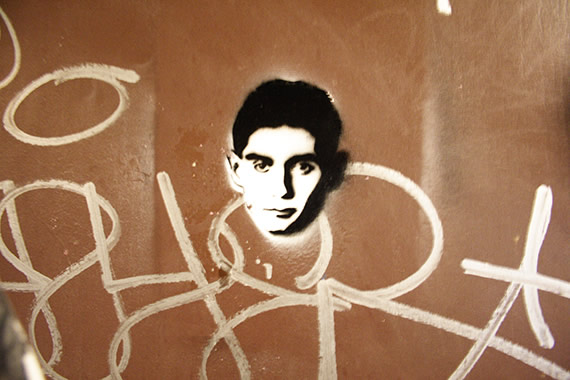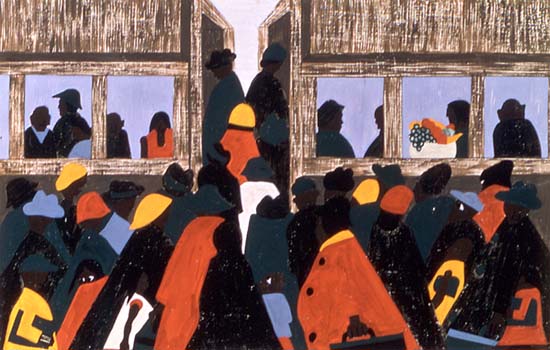Hi,
I hope that you were informed of my absence and of the need to check this blog.
Those students who have given me a Yellow Wallpaper draft or freewriting, and who want your paper back soon, so that you might work on it, should know that I'll be on campus tomorrow in the G building. At 9 I'll be in G 211 and at 1pm I will be in G 101. At other times, you'll find me in my office, G 108.
If you don't find me on campus, that means I needed more time to recover. If that's the case, or you are not on campus on Thursdays, email me and we'll see what we can do.
Thanks,
Prof. Hebert
Wednesday, April 27, 2011
Tuesday, April 12, 2011
Poster Boy, Artist + Vigilante :: Friends We Love Profile
So what do you think of this? Is this art?
Friday, April 8, 2011
Kafka's letter to his father
Reading Kafka could make you smarter

Science Daily (Sept. 16, 2009)-- Reading a book by Franz Kafka --- or watching a film by director David Lynch--- could make you smarter.
According to research by psychologists at UC Santa Barbara and the University of British Columbia, exposure to the surrealism in, say, Kafka's "The Country Doctor" or Lynch's "Blue Velvet" enhances the cognitive mechanisms that oversee implicit learning functions. The researchers' findings appear in an article published in the September issue of the journal Psychological Science.
"The idea is that when you're exposed to a meaning threat -- something that fundamentally does not make sense -- your brain is going to respond by looking for some other kind of structure within your environment," said Travis Proulx, a postdoctoral researcher at UCSB and co-author of the article. "And, it turns out, that structure can be completely unrelated to the meaning threat."
Meaning, according to Proulx, is an expected association within one's environment. Fire, for example, is associated with extreme heat, and putting your hand in a flame and finding it icy cold would constitute a threat to that meaning. "It would be very disturbing to you because it wouldn't make sense," he said.
As part of their research, Proulx and Steven J. Heine, a professor of psychology at the University of British Columbia and the article's second co-author, asked a group of subjects to read an abridged and slightly edited version of Kafka's "The Country Doctor," which involves a nonsensical -- and in some ways disturbing -- series of events. A second group read a different version of the same short story, one that had been rewritten so that the plot and literary elements made sense. The subjects were then asked to complete an artificial-grammar learning task in which they were exposed to hidden patterns in letter strings. They were asked to copy the individual letter strings and then to put a mark next to those that followed a similar pattern.
"People who read the nonsensical story checked off more letter strings -- clearly they were motivated to find structure," said Proulx. "But what's more important is that they were actually more accurate than those who read the more normal version of the story. They really did learn the pattern better than the other participants did."
In a second study, the same results were evident among people who were led to feel alienated about themselves as they considered how their past actions were often contradictory. "You get the same pattern of effects whether you're reading Kafka or experiencing a breakdown in your sense of identity," Proulx explained. "People feel uncomfortable when their expected associations are violated, and that creates an unconscious desire to make sense of their surroundings. That feeling of discomfort may come from a surreal story, or from contemplating their own contradictory behaviors, but either way, people want to get rid of it. So they're motivated to learn new patterns."
Thus far, the researchers have identified the beneficial effects of unusual experiences only in implicit pattern learning. It remains to be seen whether or not reading surreal literature would aid in the learning of studied material as well. "It's important to note that sitting down with a Kafka story before exam time probably wouldn't boost your performance on a test," said Proulx.
"What is critical here is that our participants were not expecting to encounter this bizarre story," he continued. "If you expect that you'll encounter something strange or out of the ordinary, you won't experience the same sense of alienation. You may be disturbed by it, but you won't show the same learning ability. The key to our study is that our participants were surprised by the series of unexpected events, and they had no way to make sense of them. Hence, they strived to make sense of something else."
Source: Association for Psychological Science (news : web)
Friday, March 18, 2011
The Surreal
 Rene Magritte, The Lovers.
Rene Magritte, The Lovers.In high school I saw this painting and was inspired to write a poem. What do you think of the painting?
Merriam Webster dictionary definition of Surrealism: the principles, ideals, or practice of producing fantastic or incongruous imagery or effects in art, literature, film, or theater by means of unnatural or irrational juxtapositions and combinations
Below is The Empire of Lights also by the French Surrealist, Rene Magritte. Do you notice anything irrational or unnatural? Click on the painting for a full view.

Below is the surrealist painting, Persistence of Time by Salvador Dali. Have you seen this painting before? Click on it for the full painting. It looks like a scene Gregor Samsa might wake up to, if he hadn't already turned into a bug! The work of Frida Kahlo, a Mexican artist, has often been described as surreal or dream-like. Here is her painting What the Water Gave Me. You decide.

Also by Kahlo, The Two Fridas. Click on image for full painting.

Wednesday, March 9, 2011
The Violence of Grace
 Caravaggio, The Conversion of St. Paul on the Road to Damascus (Click on image for full painting)
Caravaggio, The Conversion of St. Paul on the Road to Damascus (Click on image for full painting)On his way to Damascus, Saul is knocked from his horse, blinded for 3 days in a violent moment of conversion captured here by Caravaggio, an Italian artist between 1593 and 1610, considered the first great representative of the Baroque school of painting. This is Flannery O'Connor's grandmother, hat knocked off to one side, legs askew, sitting on the dusty road. Some vacation!
Here is another painting by Caravaggio, The Martyrdom of St. Matthew. Notice how the sword of death is coming, as Matthew reaches to the angel's extended hand. Again, click the image, for the full painting.

Monday, February 28, 2011
Jacob Lawrence Harlem Renaissance Artist

Jacob Lawrence, Migration Spreads (from the Migration Series)

Jacob Lawrence, One of the first Race Riots Occurred in East St. Louis (from the Migration Series)
Jacob Lawrence (September 7, 1917 – June 9, 2000) was an African American painter; he was married to fellow artist Gwendolyn Knight. Lawrence referred to his style as "dynamic cubism", though by his own account the primary influence was not so much French art as the shapes and colors of Harlem. Lawrence is among the best-known twentieth century African American painters, a distinction shared with Romare Bearden. Lawrence was only in his twenties when his "Migration Series" made him nationally famous. The series of paintings was featured in a 1941 issue of Fortune magazine. The series depicted the epic Great Migration of African Americans from the rural South to the urban North.
Go to this url to see the slide show of the complete Migration Series
http://www.phillipscollection.org/migration_series/flash/experience.cfm
Here are more of Jacob Lawrence's paintings. Click on the image to get a full view. What do you think of them?

Jacob Lawrence, Harlem

Jacob Lawrence, Story Painter

Jacob Lawrence, Barber Shop (click on image to see full view)
Subscribe to:
Comments (Atom)

